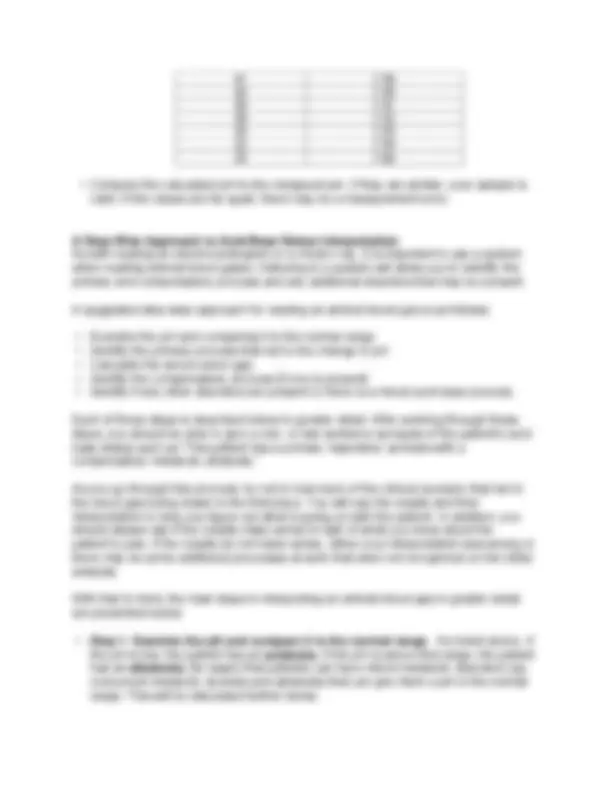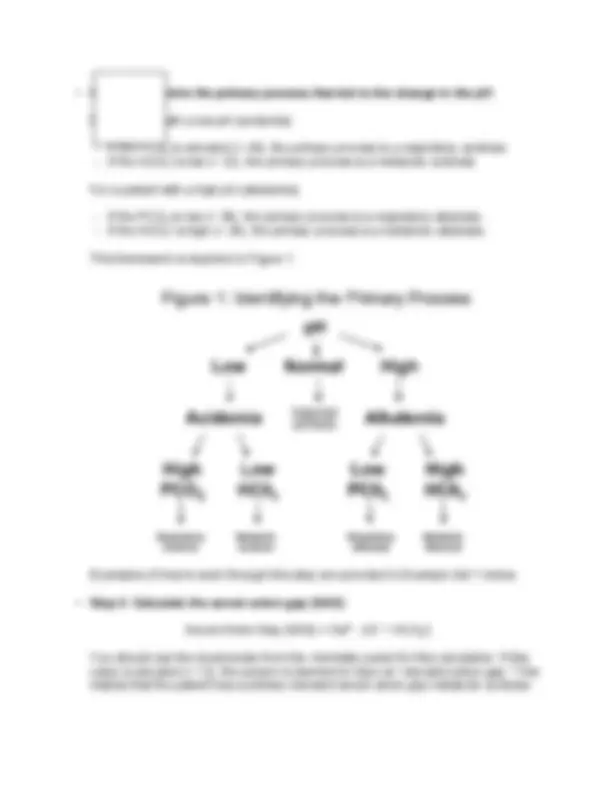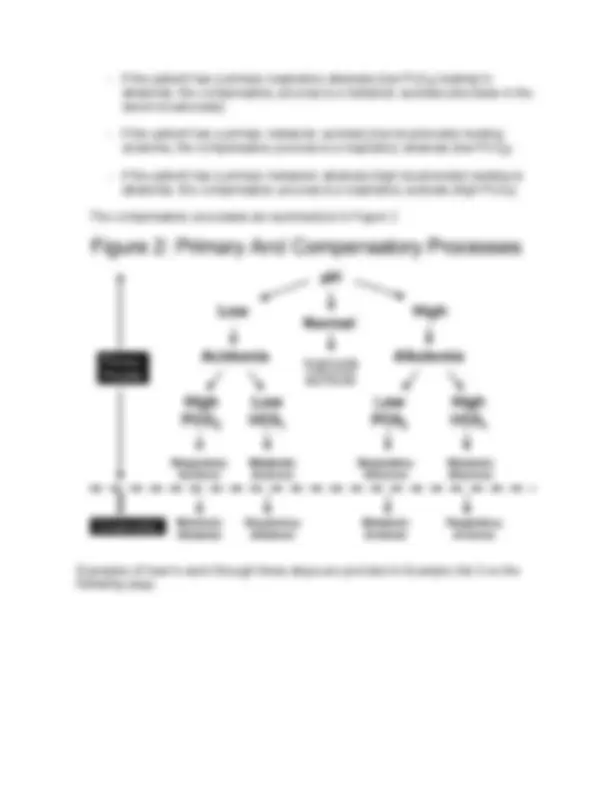
















Study with the several resources on Docsity

Earn points by helping other students or get them with a premium plan


Prepare for your exams
Study with the several resources on Docsity

Earn points to download
Earn points by helping other students or get them with a premium plan
Community
Ask the community for help and clear up your study doubts
Discover the best universities in your country according to Docsity users
Free resources
Download our free guides on studying techniques, anxiety management strategies, and thesis advice from Docsity tutors
This primer provides a clinical approach to interpreting arterial blood gases, focusing on a step-wise approach to identify primary processes leading to changes in pH, calculate the anion gap, and determine compensatory processes. It also discusses the importance of considering mixed acid-base disorders and the relationship between respiratory and metabolic compensation.
Typology: Exercises
1 / 22

This page cannot be seen from the preview
Don't miss anything!















Andrew M. Luks, MD
Arterial blood gases play an important role in the work-up and management of critically ill patients and patients with a variety of pulmonary complaints and disorders. For example, they are used to guide the adjustment of ventilator parameters on mechanically ventilated patients and are also a standard part of the work-up of patients who present with unexplained hypoxemia or dyspnea. It is, therefore, important that students and physicians be able to interpret the results of arterial blood gas sampling, determine the patient’s acid-base status and assess the adequacy of oxygenation.
This primer describes a clinical approach to interpreting arterial blood gases. It will outline a step-wise approach to interpreting the acid-base status and generating differential diagnoses for the observed problems. It will then address the proper means for assessing the adequacy of oxygenation and determining the etiology of any observed abnormalities.
The physiologic principles underlying acid-base physiology are beyond the scope of this review and will not be considered here, but information about this topic can be obtained from the following additional resources:
Terms and Normal Values Before reviewing the assessment of acid-base status, it is helpful to review the normal values for the main acid-base parameters and some basic terminology.
The normal values for acid-base parameters are as follows:
Be aware that the normal ranges for these parameters will vary slightly from laboratory to laboratory.
The following terminology is applied to acid-base interpretation:
It is important to keep these terms straight in your mind and in your communications with others. It is common for people to refer to the patient with a low pH, for example, and say they are “acidotic.” Similarly, they often refer to the patient with a high pH as “alkalotic.” This is incorrect terminology. When you are referring to the patient and their pH, the correct terminology is as follows:
How the Data Are Presented While the laboratory will always label each value in the arterial blood gas results, it is not uncommon for residents, fellows and attending physicians to either write or state the results without labeling each value. For example, rather than stating: “the pH is 7.40, the PCO 2 is 40, the PO 2 is 85 and the HCO 3 -^ is 24” they may simply state or write: “7.4/40/85/24.”
If ABG results are presented in this manner, by convention, they will be written or spoken in the following order: pH Æ PCO 2 Æ PO 2 Æ HCO 3 -
Before you get started…. Make Sure the Numbers Are Consistent
41 7. 40 7. 39 7. 38 7. 35 7. 32 7. 25 7.
A Step-Wise Approach to Acid-Base Status Interpretation As with reading an electrocardiogram or a chest x-ray, it is important to use a system when reading arterial blood gases. Adhering to a system will allow you to identify the primary and compensatory process and any additional disorders that may be present.
A suggested step-wise approach for reading an arterial blood gas is as follows:
Each of these steps is described below in greater detail. After working through these steps, you should be able to give a one- or two-sentence synopsis of the patient’s acid- base status such as “This patient has a primary respiratory acidosis with a compensatory metabolic alkalosis.”
As you go through this process, try not to lose track of the clinical scenario that led to the blood gas being drawn in the first place. You will use the results and their interpretation to help you figure out what is going on with the patient. In addition, you should always ask if the results make sense in light of what you know about the patient’s case. If the results do not make sense, either your interpretation was wrong or there may be some additional processes at work that were not recognized on the initial analysis.
With that in mind, the main steps in interpreting an arterial blood gas in greater detail are presented below.
For a patient with a low pH (acidemia)
For a patient with a high pH (alkalemia)
This framework is depicted in Figure 1.
Examples of how to work through this step are provided in Example Set 1 below.
Serum Anion Gap (SAG) = Na +^ - (Cl-^ + HCO 3 - )
You should use the bicarbonate from the chemistry panel for this calculation. If this value is elevated (> 12), the person is deemed to have an “elevated anion gap.” This implies that the patient has a primary elevated serum anion gap metabolic acidosis
does not generate an anion gap in order to compensate for a primary respiratory disorder.
Be aware, however, that an elevated anion gap acidosis may not be the only primary process. For example, patients with salicylate intoxication may have a primary respiratory alkalosis and a concurrent primary elevated anion gap acidosis at the same time. An example of this situation is provided in Example Set 2.
Example Set 2
A 30 year-old woman is brought into the emergency room with altered mental status. Her friends found her at home with an empty bottle of aspirin by her bedside. Her S (^) p O 2 is 99% and she is obviously hyperventilating on exam. An arterial blood gas is obtained as part of her initial work-up and reveals: pH 7.56, PCO 2 22, PO2 110, HCO 3 Š17. On her chemistry panel, her sodium is 137, chloride 99, bicarbonate 18.
Step 1: The pH is high (alkalemia)
Step 2: The PCO 2 is low (respiratory alkalosis) and the bicarbonate is low (metabolic acidosis). A high pH with a low PCO 2 indicates that the primary process is a respiratory alkalosis.
Step 3: The serum anion gap is elevated at 20. As a result, she also has an elevated anion gap acidosis going on at the same time.
Summary: This combination of alkalemia due to a primary respiratory alkalosis with a concurrent elevated anion gap metabolic acidosis is classic for salicylate intoxication.
You should also note that the normal anion gap is affected by the patient’s serum albumin level. As a general rule of thumb, the normal anion gap is roughly three times the albumin value. By way of example, for a patient with an albumin of 4.0, the normal anion gap would be 12. For a patient with chronic liver disease and an albumin of 2.0, the upper limit of normal for the anion gap would be 6. Other people propose that the ceiling value for a normal anion gap is reduced by 2.5 for every 1g/dL reduction in the plasma albumin concentration.
The compensatory processes are summarized in Figure 2.
Examples of how to work through these steps are provided in Example Set 3 on the following page.
Important Points Regarding Compensatory Processes There are several important points to be aware of regarding these compensatory processes:
If there is a large rise in the PCO 2 , this equation will shift towards the right and the levels of bicarbonate will transiently increase. Similarly, a large fall in the PCO 2 would shift the equation to the left and the bicarbonate would transiently decrease. How can you figure out whether the observed changes in bicarbonate represent true compensation or changes due to this relationship? The answer lies in another value you will see reported with the arterial blood gas – the base excess. In general, as you may recall from respiratory physiology, the base excess is defined as the difference between the patient’s HCO 3 -^ after correction to a pH of 7.4 by a change in the PCO 2 and the normal HCO 3 -^ at pH 7.4. It can be used in the following manner to interpret changes in the HCO 3 -^ levels.
Be aware that if the base excess is less than -2 or greater than + 2, and therefore, a metabolic process is present, the base excess value itself does not tell you whether this is a primary process or a compensatory process. It only tells you a metabolic process is present. You still need to work through the steps described here to tell whether it is the primary process or the compensatory process.
Be aware that for these calculations to work, the chemistry panel and blood gas must have been drawn at roughly the same time. If, for example, you obtain a blood gas on a patient during a code on a patient at 6PM, you cannot use the morning chemistry panel from 6AM to do these calculations.
Examples of how to work through this last step of the process are provided in Example Set 4 below.
Example Set 4
Case A You are working in the emergency room when the paramedics bring in a 45 year-old man who was found down in Pioneer Square. He is somnolent but arouseable. He has emesis on his shirt. He is hypotensive and tachycardic. Labs are drawn and reveal the following: room air ABG: pH 7.22, PCO 2 29, PO 2 78, HCO 3 -^ 11. Chemistry panel: Na +^ 131, Cl -^ 90, HCO 3 -^ 12. Glucose 135.
Step 1: The pH is low (acidemia) Step 2: The PCO 2 is low (respiratory alkalosis) and the bicarbonate is low (metabolic acidosis). Therefore, the metabolic acidosis is the primary process. Step 3: The serum anion gap is elevated at 29. There is, therefore, an elevated anion gap acidosis. Step 4: The respiratory alkalosis is the compensatory process for the metabolic acidosis. Step 5:
The Delta Gap = Measured SAG Š Normal SAG = 29 Š 12 = 17 Calculate the Delta Delta: Delta Gap + measured bicarbonate = 17 + 12 = 29 Since the Delta Delta is above a normal bicarbonate level, there is a concurrent metabolic alkalosis at work.
Summary: The patient has a primary elevated anion gap acidosis with respiratory compensation (which is not complete) and a concurrent metabolic alkalosis. You would need to sort through the differential diagnosis for an elevated anion gap acidosis to identify the cause of that problem. The metabolic alkalosis is likely due to vomiting.
Example Set 4 (continued)
Case B A 60 year-old man was recently in the hospital for treatment of aspiration pneumonia for which he as treated with levofloxacin and clindamycin. One week later, he presents to the ER with severe diarrhea, abdominal pain and hypotension. He is admitted to the ICU where an arterial blood gas shows: pH 7.29, PCO 2 25, PO 2 89, HCO 3 -^ 10. On his chemistry panel, he has: Na+^ 129, Cl -^ 99, HCO 3 -^ 10. Glucose 135.
Step 1: The pH is low (acidemia) Step 2: The PCO 2 is low (respiratory alkalosis) and the bicarbonate is low (metabolic acidosis). Therefore, the metabolic acidosis is the primary process. Step 3: The serum anion gap is elevated at 20. There is, therefore, an elevated anion gap acidosis. Step 4: The respiratory alkalosis is the compensatory process for the metabolic acidosis. Step 5:
The Delta Gap = Measured SAG Š Normal SAG = 20 Š 12 = 8 Calculate the Delta Delta: Delta Gap + measured bicarbonate = 8 + 10 = 18 Since the Delta Delta is below the normal bicarbonate level, there is a concurrent non-gap metabolic acidosis at work.
Summary: The patient has a primary elevated anion gap acidosis with respiratory compensation and a concurrent non-gap metabolic acidosis. He likely has sepsis from C.Difficile Colitis as the cause of his elevated anion gap acidosis. The non-gap acidosis may be from his severe diarrhea (a source of bicarbonate loss).
Case C A 56 year-old woman with chronic kidney disease presents to the emergency room with increasing dyspnea. She is noted to be tachypneic, but is afebrile, has a normal lung exam and a normal appearing chest x-ray. An arterial blood gas is drawn and reveals: pH 7.28, PCO 2 29, PO 2 85, HCO 3 -^ 16. On her chemistry panel, the sodium is 131, chloride 105 and HCO 3 -^ 15.
Step 1: The pH is low (acidemia) Step 2: The PCO 2 is low (respiratory alkalosis) and the bicarbonate is low (metabolic acidosis). Therefore, the metabolic acidosis is the primary process. Step 3: The serum anion gap is normal at 11. The patient, therefore, does not have an elevated anion gap acidosis Step 4: The respiratory alkalosis is the compensatory process for the metabolic acidosis. Step 5:
The Delta Gap = Measured SAG Š Normal SAG = 11 Š 12 - Calculate the Delta Delta: Delta Gap + measured bicarbonate = -1 + 15 = 14 The Delta Delta is below the normal bicarbonate level. This tells us there is a non-gap acidosis, but in this case, this acidosis is actually the same acidosis that you identified in Steps 2 and 3 and there are no additional metabolic processes at work.
Summary: The patient has chronic kidney disease. Many such patients develop non-gap acidoses due to renal tubular acidosis.
As noted above, in several of these cases (eg. carbon monoxide poisoning, excess beta-agonists), the elevated anion gap derives from accumulation of lactate.
You should also be aware that there is a differential diagnosis for a low serum anion gap. It includes the following items:
If the cause of the non-gap acidosis is not clear based on the patient history, you can identify whether the problem is renal or gastrointestinal losses by calculating a urine anion gap:
Urine Anion Gap (UAG) = (Urine Na +^ + Urine K+^ ) – Urine Cl -
A positive value (UAG > 0) suggests the metabolic acidosis is due to a renal etiology, whereas a negative value (UAG < 0) points to a gastrointestinal source.
Chloride Responsive Alkaloses:
Chloride Unresponsive Alkaloses:
If the cause of the metabolic alkalosis is not clear based on the patient history, you can obtain a urine chloride level to help determine the cause. If the urine chloride level is < 15 the patient has a “chloride responsive alkalosis” which can be corrected with saline (NaCl) administration. This typically happens with gastrointestinal losses or intravascular volume depletion (i.e. a contraction alkalosis with diuretic use). If the urine chloride is > 15, the patient has a “Chloride Unresponsive Alkalosis”
Use Old Arterial Blood Gas Results to Your Advantage There are certain clinical situations where a review of the patient’s prior arterial blood gas results can be of great value (if the patient did, in fact, have a sample drawn in the past). To see how prior ABG results may be of use, consider the following scenario.
term of the alveolar gas equation (PI O 2 = [PB – 47] FI O 2 ). For example, the PI O 2 while breathing ambient air at sea level is 150 mmHg whereas if you live in Boise, Idaho, where the average PB is 695 mmHg, the PI O 2 of room air is 135 mmHg.
Once you have calculated this value, the AaO 2 Difference is calculated as follows:
AaO 2 D = PA O 2 – Pa O (^2)
The normal value for the AaO 2 Difference is about 10-15 mm Hg. If you determine that the patient has a normal AaO 2 Difference, then the hypoxemia can be attributed to hypoventilation or a low inspired partial pressure of oxygen. If, however, you find that the patient has an elevated AaO 2 difference then they have some process going on that is causing shunt or low V/Q, such as pneumonia, that is contributing to the observed hypoxemia.
There are a few important points to be aware of regarding the use of the AaO 2 Difference.
Assessing the Adequacy of Gas Exchange Suppose your patient has Pa O 2 of 85 that results in an Sp O 2 around 97-98%. Even though these values are adequate for sustaining the patient, they do not mean that gas exchange is normal. In fact, a patient can have a Pa O 2 and Sp O 2 in this range and still have markedly abnormal gas exchange. As a result, whenever you interpret the Pa O 2 on an arterial blood gas, you must look at that number in light of the amount of oxygen that
is being delivered to the patient. There are several ways you can get a sense of this value:
Both methods for assessing the adequacy of gas exchange require an accurate FI O (^2) measurement, which, as noted above, can only be assured if the patient is on room air, a high flow face mask, non-invasive mechanical ventilation or invasive mechanical ventilation.
Special Situations To Be Aware of In Evaluating the Pa O 2 on an ABG There are a few special situations of which you should be aware when assessing the Pa O 2 on an arterial blood gas.